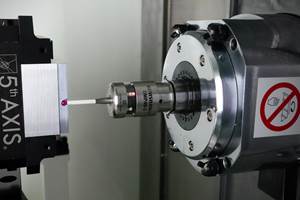DFGT - Double Flank Gear Testing
Functional gear testing, also known as total radial composite deviation, is a method of looking at the total effect of gear errors. This test method simulates the conditions under which a set of gears is likely to operate as a result of the gears meshing together.
Functional gear testing, also known as total radial composite deviation, is a method of looking at the total effect of gear errors. This test method simulates the conditions under which a set of gears is likely to operate as a result of the gears meshing together. The most common form of this test places the gears in a tight mesh, which produces contact on both flanks. Thus, the name of the gage to test this is aptly referred to as a double flank gear tester.
The other, less often used method of functional gear testing mounts the gears at their fixed operating distance. This method produces contact on a single flank of each of the meshing teeth. Believe it or not, the name of this type of gage is a single flank gear tester.
Most indicator type gear testing (rolling) instruments are manually operated. These instruments are designed for use on the shop floor to monitor gear cutting quality. The use of these rolling gear testers is becoming more important as tolerances and machining requirements get tougher for metal and plastic gears.
Building a double flank gear tester is very similar to building any other type of comparative gage, except that with this type of comparator, the master will be kept in the gage as part of the measuring loop. (See the figure below for a typical rolling gear gage schematic.)
The work gear, or the gear being inspected, is mounted to a precision fixed arbor. A precision master gear is then mounted to an adjustable slide and brought into contact with the work gear. If variations between the work gear and the parameters of the master gear are apparent, rolling the two gears together in a tight mesh will result in a change in their center distance. This change reflects the total composite gear action that can be caused by improper gear profile, tooth thickness variations, gear runout or pitch errors. Surface finish errors, nicks or scratches in the gear teeth can also contribute to center distance variation.
The master gear used to inspect the work gear is just like any other comparative master in that it must be manufactured to a quality level substantially higher than that of the work gear. Just as there are level grades for gage blocks and master balls, likewise, standards organizations have defined different quality levels for master gears. The master gear tolerances define the maximum variation for total and tooth-to-tooth errors.
Once the master and work gear are tightly meshed and running together, the composite variation needs to be recorded. The variation, or error, can be viewed by monitoring the position of the master gear with a comparative indicator of some type (mechanical or electric). The data can then be captured with a strip chart recorder or collected and analyzed by computer.
The common method for evaluating the composite error is with the strip chart recorder. (The above figure is an example of the result of a typical gear-rolling gage.) When the gage is run over a complete revolution of the work gear, it's easy to interpret the total composite variation and the tooth-to-tooth composite variation. To make it even easier, some gages use tolerance lines on the strip chart, limit lights on the amplifier or impose software limits to reduce operator involvement measurement in interpretation.
Related Content
4 Ways to Establish Machine Accuracy
Understanding all the things that contribute to a machine’s full potential accuracy will inform what to prioritize when fine-tuning the machine.
Read MoreHow to Choose the Right Cut Off When Measuring Roughness
Measurement results for surface finishing parameters can vary depending on the filter parameter (Lc), also known as the cutoff.
Read MoreWhat Should Machinists Know About In-Machine Probing?
In-machine probing doesn’t reach the power of CMMs but can still be useful for pre- and mid-process control, as well as for “rough screening” of parts.
Read MoreDetermining Out-of-Roundness at the Point of Manufacture
George Schuetz, Mahr Inc.’s Director of Precision Gages, offers these techniques for measuring roundness on the shop floor.
Read MoreRead Next
3 Mistakes That Cause CNC Programs to Fail
Despite enhancements to manufacturing technology, there are still issues today that can cause programs to fail. These failures can cause lost time, scrapped parts, damaged machines and even injured operators.
Read MoreThe Cut Scene: The Finer Details of Large-Format Machining
Small details and features can have an outsized impact on large parts, such as Barbco’s collapsible utility drill head.
Read More








.png;maxWidth=300;quality=90)













